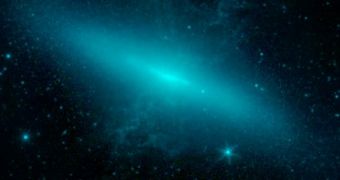On January 21, 2014, a massive supernova explosion was recorded in the Cigar Galaxy. Telescopes around the world and in orbit were immediately pointed to the blast site, but many of them were unable to clearly see the object in optical and ultraviolet wavelengths. The NASA Spitzer Space Telescope now provides a clear view of the luminous event at infrared frequencies.
The Cigar Galaxy – also known as Messier 82, M82, and NGC 3034 – lies around 11.5 million light-years away from Earth, give or take 0.8 million light-years. In late January, it hosted the closest supernova to our planet ever observed in several decades.
Unlike previous instances when such events occurred, this time astronomers were ready, and multiple telescopes were at hand to observe the blast. Supernova explosions are so powerful that they can briefly outshine entire galaxies. However, the one in M82 was special, due to the fact that the core of the galaxy is smothered in dust.
This material absorbed a vast amount of radiation and light that was released during the explosion, so telescopes observing the night sky in optical and ultraviolet wavelengths had a difficult time obtaining details about the supernova. This is where the SSC came in. The observatory used its sensitive IR detectors to pierce the dust cover and see the blast in more detail.
“At this point in the supernova's evolution, observations in infrared let us look the deepest into the event. Spitzer is really good for bypassing the dust and nailing down what's going on in and around the star system that spawned this supernova,” says researcher Mansi Kasliwal.
The expert holds an appointment as a Hubble and Carnegie-Princeton Fellow at the Observatories of the Carnegie Institution for Science, and is also the principal investigator for Spitzer's sessions. He says that the new event – dubbed SN 2014J – is a Type Ia supernova, meaning that it was triggered by the explosion of a white dwarf in a binary system.
Spitzer first observed SN 2014J on January 28. Additional observations were conducted on February 7, 12, 19 and 24, and another session is currently scheduled for March 3. All the data the telescope gathers will be stitched to observations conducted in other portions of the electromagnetic spectrum, to create a comprehensive view of the blast and its characteristics.
In addition to Spitzer, other telescopes conducting observations of SN 2014J include the NASA/ESA Hubble Space Telescope, the NASA Chandra X-ray Observatory, the NASA Nuclear Spectroscopic Telescope Array (NuSTAR), the NASA Fermi Gamma-ray Space Telescope, the NASA Swift Gamma Ray Burst Explorer, and the NASA/DLR Stratospheric Observatory for Infrared Astronomy (SOFIA).

 14 DAY TRIAL //
14 DAY TRIAL //